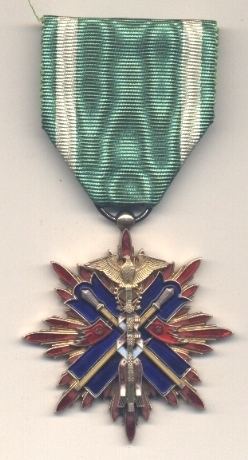Established 12 February 1890 | ||
 | ||
Type Seven-class military award Eligibility Military personnel only Awarded for Bravery, leadership or command in battle. Campaign(s) First Sino-Japanese WarRusso-Japanese WarWorld War IManchurian IncidentSecond Sino-Japanese WarPacific War Status No longer awarded; abolished in 1947 | ||
The Order of the Golden Kite (金鵄勲章, Kinshi Kunsho) was an order of the Empire of Japan, established on 12 February 1890 by Emperor Meiji "in commemoration of Jimmu Tennō, the Romulus of Japan." It was officially abolished by the Supreme Commander of the Allied Powers of Occupied Japan in 1947 after World War II.
Contents
Background
The Order of the Golden Kite was an exclusively military award, conferred for bravery, leadership or command in battle. It ranked just below the Order of the Chrysanthemum in precedence and was the military equivalent of the Order of the Paulownia Flowers; therefore, it could be considered analogous to the military division of the Order of the Bath in the United Kingdom. The first three classes were roughly equivalent to the three divisions of the Order of the Bath, the fourth, fifth, sixth and seventh classes were analogous to the DSO, MC/DSC, DCM/CGM and DSM/MM, respectively.
The order consisted of seven classes. Enlisted rank soldiers were eligible for the 7th - 5th classes, non-commissioned officers were eligible for the 6th - 4th classes, junior officers for the 5th - 3rd classes, field grade officers for the 4th-2nd classes and general officers for the 3rd-1st classes.
A total of 1,067,492 Order of the Golden Kite awards were made over the history of the order, most of them in the two lower 6th and 7th classes. Only 41 of the 1st class and 201 of the 2nd class were awarded.
By conflict:
The award came with an annual monetary stipend, fixed in 1916. This was awarded for the lifetime of the recipient, and following his death, it would be awarded to the recipient's family for one year after. If the recipient died within 5 years of receiving the honor, the stipend would be awarded to the family until the end of the 5-year period. In 1939, the stipends stood as follows:
Since the monthly pay for a private in the Imperial Japanese Army at the time was 8 Yen, 80 sen, this amounted to a very substantial reward. The monetary stipend was abolished in 1940.
The honor was sometimes awarded individually, sometimes awarded en masse. In mid-October 1942, posthumous awards were announced following ceremonies at the Yasukuni Shrine. Posthumous honorees included 995 who were lost in combat in the far-flung Pacific War battles and 3,031 were lost fighting in China. In this instance, Tokyo's official radio broadcast of the list of posthumous recipients of the Order of the Golden Kite was monitored by Allied forces in Asia. The number of honorees was not considered remarkable at the time, but the number of posthumous awards was considered noteworthy by Allied analysts. Specific high ranking naval and army officers were named; and in addition, special mention was given to 55 naval aviators and 9 "members of a special attack flotilla"—presumably miniature submarines taking part in the attack on Pearl Harbor.
The order of the Golden Kite was officially abolished by the Supreme Commander of the Allied Powers of Occupied Japan in 1947.
Symbolism
The badge depicts a golden kite, a messenger of the kami as described in the ancient Japanese chronicle Nihon Shoki, which helped Emperor Jimmu defeat his enemies in battle. The golden kite stands on an eight-pointed star with 32 rays enameled in red. Below the kite are two crossed ancient samurai shields, enameled blue, with two crossed swords enameled yellow, with silver hilts. On one side is a halberd (enameled green with white trappings), with the mitsu tomoe Shinto symbol on red banners. The reverse side is plain.
The badge was gilt for the 1st-5th classes and silver for the 5th-7th classes. It was suspended on a ribbon in blue-green with a white stripe near the edges, worn as a sash on the right shoulder by the 1st class, as a necklet by the 2nd and 3rd classes, on the left chest by the 4th and 5th classes. The badges for 6th and 7th classes were non-enameled.
The star of the 1st and 2nd classes was similar to the badge as described above, but with both red and yellow enameled rays. It was worn on the left chest by the 1st class, on the right chest by the 2nd class.
